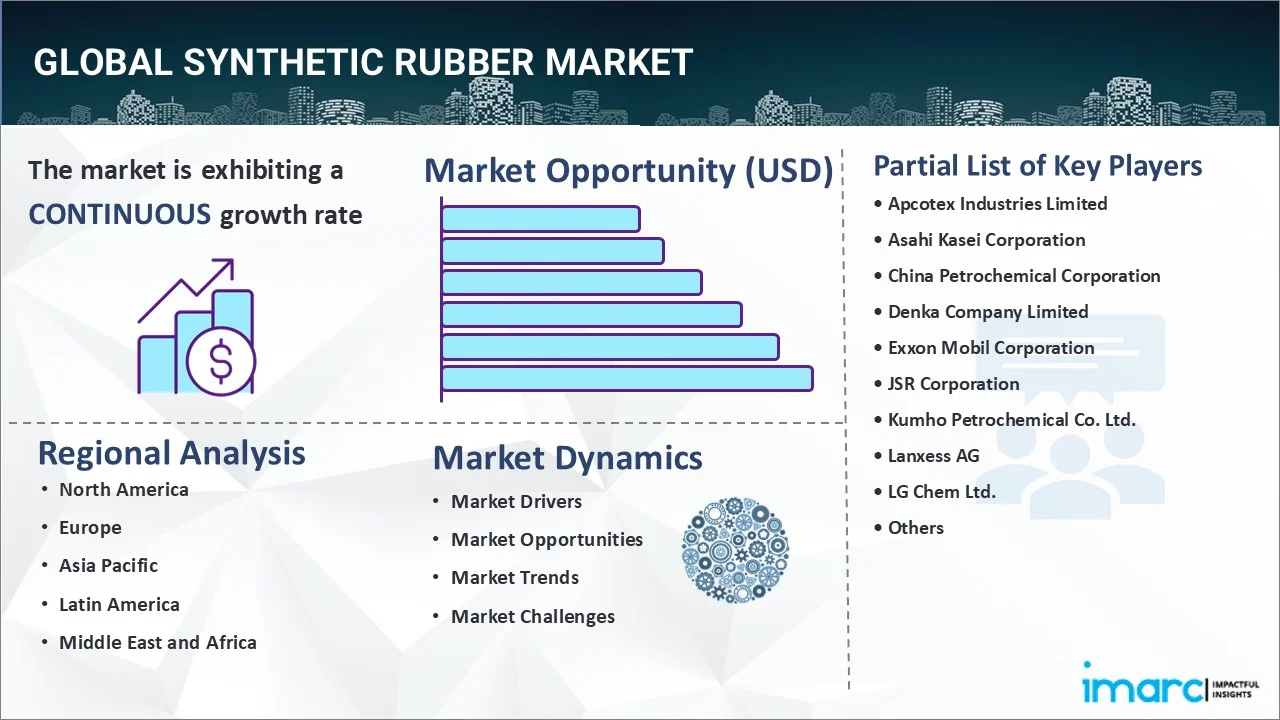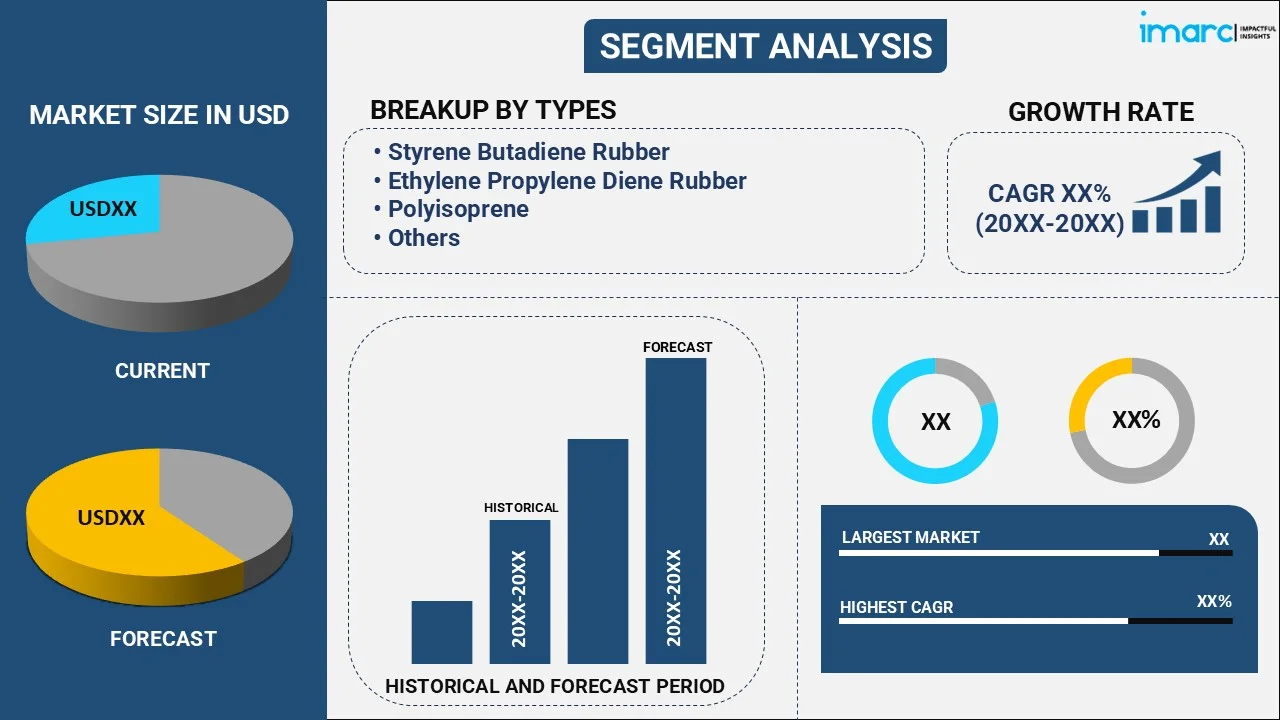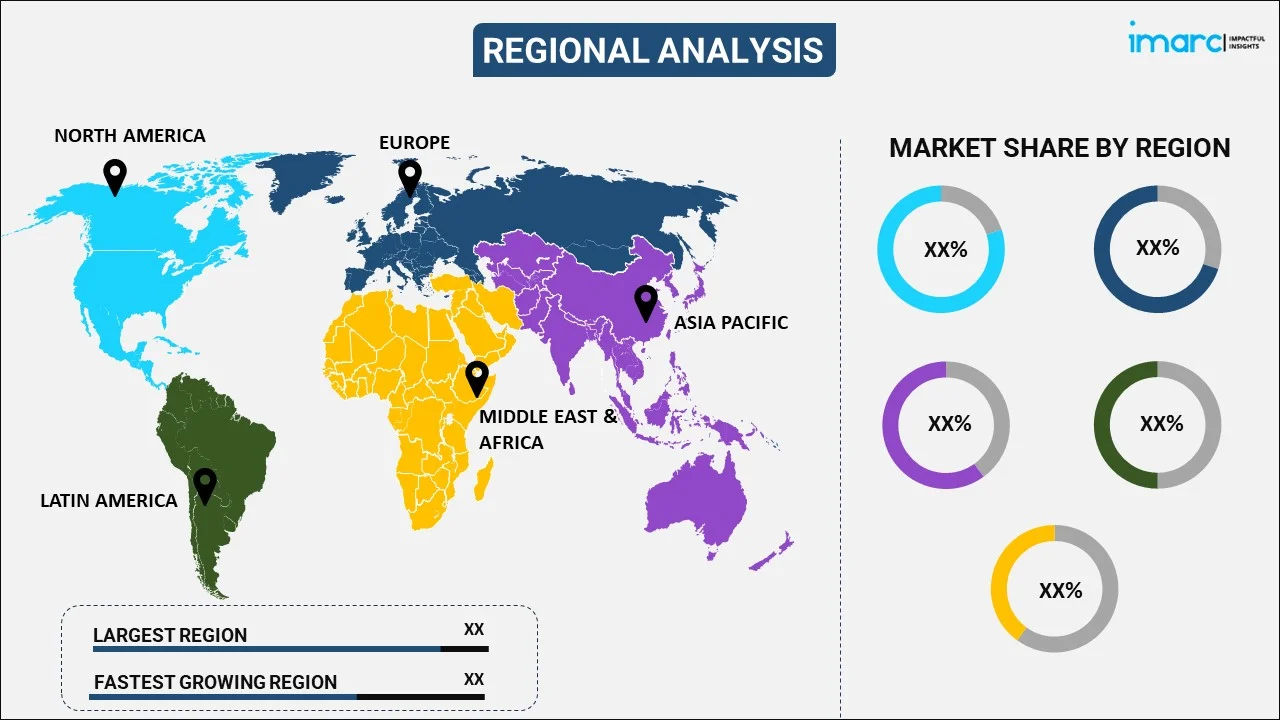
Synthetic Rubber Market Report by Type (Styrene Butadiene Rubber, Ethylene Propylene Diene Rubber, Polyisoprene, Polybutadiene Rubber, Isobutylene Isoprene Rubber, and Others), Form (Liquid Synthetic Rubber, Solid Synthetic Rubber), Application (Tire and Tire Component, Non-Tire Automobile Application, Footwear, Industrial Goods, and Others), and Region 2025-2033
Global Synthetic Rubber Market:
The global synthetic rubber market size reached USD 34.2 Billion in 2024. Looking forward, IMARC Group expects the market to reach USD 44.8 Billion by 2033, exhibiting a growth rate (CAGR) of 3% during 2025-2033. Rapid technological advancements, implementation of stringent environmental regulations, expanding product applications across various industries, especially automotives, are some of the key factors propelling the market growth.
|
Report Attribute
|
Key Statistics
|
|---|---|
|
Base Year
|
2024 |
|
Forecast Years
|
2025-2033
|
|
Historical Years
|
2019-2024
|
| Market Size in 2024 | USD 34.2 Billion |
| Market Forecast in 2033 | USD 44.8 Billion |
| Market Growth Rate (2025-2033) | 3% |
Synthetic Rubber Market Analysis:
- Major Market Drivers: The increasing product demand across various sectors, such as automotive, construction, and consumer goods, is primarily driving the growth of the market. Additionally, advancements in synthetic rubber technology and stringent environmental regulations push for sustainable products.
- Key Market Trends: The key market trends involve the ongoing shift towards the development of eco-friendly and sustainable synthetic rubber products in response to rising environmental concerns and regulatory policies.
- Geographical Landscape: The Asia Pacific region stands as the largest segment in the synthetic rubber market, driven by rapid industrialization, significant growth in the automotive sector, and the presence of key manufacturing hubs in various countries. In line with this, countries such as China, India, Japan, South Korea, Thailand, and Indonesia are home to major tire-producing companies in the world.
- Competitive Landscape: Some of the leading synthetic rubber market companies are Apcotex Industries Limited, Asahi Kasei Corporation, China Petrochemical Corporation, Denka Company Limited, Exxon Mobil Corporation, JSR Corporation, Kumho Petrochemical Co. Ltd., Lanxess AG, LG Chem Ltd., PJSC Nizhnekamskneftekhim, Reliance Industries Limited, Saudi Basic Industries Corporation (Saudi Arabian Oil Co.), The Goodyear Tire & Rubber Company, TSRC Corporation, and Zeon Corporation, among many others.
- Challenges and Opportunities: The synthetic rubber market faces challenges due to fluctuations in raw material prices and environmental concerns over production processes. However, opportunities arise from the growing demand in the automotive, construction, and industrial sectors, driven by trends like urbanization and technological advancements in polymer science.

Synthetic Rubber Market Trends:
Increasing Product Demand in the Automotive Industry
The growing utilization of synthetic rubber in the automotive sector for the production of tires, hoses, belts, and other car components is one of the major factors bolstering the market growth. Tires are predominantly made by using styrene-butadiene rubber due to its durability and resistance to wear over time. Moreover, the growing vehicle production and ownership are prompting the demand for efficient automotive parts, which is positively impacting the synthetic rubber market outlook. Around 50% of car tires are made of styrene-butadiene rubber blended with natural rubber. According to the National Bureau of Statistics of China, the Chinese tire industry made about 859.19 million tires in 2022. In addition to this, the escalating demand for both commercial and passenger vehicles is significantly impacting the market for tires, which in turn is offering lucrative growth opportunities to the synthetic rubber market. For instance, according to EV-Volumes.com, the unit volume of global EV sales is projected to triple from 10.5 million in 2022 to over 31 million in 2027. Such a massive utilization of synthetic rubber in the production of tires and the bolstering demand for vehicles are anticipated to drive the market growth.
Rapid Advancements in Synthetic Rubber Technology
The rising technological innovations in the production and processing of synthetic rubber are also creating a positive outlook for the market. In line with this, the development of new synthetic rubber types with enhanced properties like improved heat resistance, lower rolling resistance in tires, and better overall performance is anticipated to propel the synthetic rubber market share. For instance, China's bionic synthetic rubber technology, developed in December 2023, achieved important breakthroughs in tire production, taking the country one step further in the domestic production of civil aircraft tires. Yang Xiaoniu, director of the Changchun Institute of Applied Chemistry of the Chinese Academy of Sciences, stated that the service life of aircraft tires made of bionic synthetic rubber is 35% longer than those made of natural rubber under extreme working conditions. Similarly, in January 2024, Qingdao Sentury Tire, in collaboration with the Qingdao Institute of Bioenergy and Processes (Qingdao Energy Institute), achieved a significant milestone in tire technology by pioneering the development of Ultra-High-Performance (UHP) tires incorporating "iron-based combed" synthetic rubber. Tires made using this technology showcased a positive impact on fuel consumption during highway-speed tests.
Widespread Diversification of Product Applications
The widespread utilization of synthetic rubber in various industries, such as construction, footwear, adhesives, and aerospace, is further propelling the synthetic rubber market revenue. Moreover, the growing versatility and ability of synthetic rubbers to be customized for specific applications is positively impacting the market growth. The widespread utilization of synthetic rubber in the construction of residential and commercial establishments, especially in emerging nations, for sealing and insulating purposes to enhance the durability and weather resistance of structures is augmenting the synthetic rubber market demand. The market size of the real estate industry in India was valued at around US$ 477 Billion in 2022 and is estimated to reach US$ 1 trillion by 2030. Additionally, approximately 4.4 billion people, or 56% of the world's population, now reside in cities. By 2050, nearly 7 out of 10 people will live in cities, with the urban population predicted to surpass its current level. Such a significant rise in urban population and bolstering demand for residential establishments is anticipated to propel the synthetic rubber market recent price in the coming years.
Synthetic Rubber Industry Segmentation:
IMARC Group provides an analysis of the key trends in each segment of the market, along with forecasts at the global, regional, and country levels for 2025-2033. Our report has categorized the market based on type, form, and application.
Breakup by Type:

- Styrene Butadiene Rubber
- Ethylene Propylene Diene Rubber
- Polyisoprene
- Polybutadiene Rubber
- Isobutylene Isoprene Rubber
- Others
Styrene butadiene rubber accounts for the majority of the market share
The report has provided a detailed breakup and analysis of the market based on the type. This includes styrene butadiene rubber, ethylene propylene diene rubber, polyisoprene, polybutadiene rubber, isobutylene isoprene rubber, and others. According to the synthetic rubber market report, styrene butadiene rubber represented the largest segment.
Styrene butadiene rubber holds the largest market share due to its excellent abrasion resistance and aging stability. Tires are predominantly made using styrene-butadiene rubber due to its durability and resistance to wear over time. It is the preferred material in the tire manufacturing sector. Around 50% of car tires are made of styrene-butadiene rubber blended with natural rubber. Besides this, the ongoing innovation in SBR formulations for enhanced performance characteristics, coupled with the growing automotive industry, is driving the market growth.
Breakup by Form:
- Liquid Synthetic Rubber
- Solid Synthetic Rubber
Solid synthetic rubber holds the largest share in the industry
A detailed breakup and analysis of the market based on the form have also been provided in the report. This includes liquid synthetic rubber and solid synthetic rubber. According to the report, solid synthetic rubber accounted for the largest market share.
Solid synthetic rubber holds the largest market share due to its versatility and ease of processing. It is employed in the automotive sector for tire manufacturing, offering excellent mechanical properties, such as abrasion resistance, durability, and flexibility. Solid synthetic rubber is also crucial in the production of industrial goods like hoses, belts, gaskets, and various molded products. It is lauded for its wide range of applications, including consumer goods like footwear, sporting goods, and toys. Additionally, solid synthetic rubber is preferred for its ease of storage and handling and its ability to be tailored through various compounding techniques to meet specific application needs.
Breakup by Application:
- Tire and Tire Component
- Non-Tire Automobile Application
- Footwear
- Industrial Goods
- Others
Tire and tire component represents the leading market segment
The report has provided a detailed breakup and analysis of the market based on the application. This includes tire and tire component, non-tire automobile application, footwear, industrial goods, and others. According to the report, tire and tire component represented the largest segment.
As per the synthetic rubber market statistics by IMARC, tire and tire components are dominating the market as synthetic rubber is integral to tire manufacturing due to its durability, resistance to wear, and flexibility. It is used in various tire components, such as the tread, sidewall, and inner liner. Moreover, the growth of the automotive sector across the globe and the increasing demand for high-performance tires are key factors contributing to the market growth. Additionally, the inflating disposable incomes of individuals and the rising need for convenient modes of transportation are augmenting the need for passenger cars. In 2021, approximately 56.4 million passenger cars were sold worldwide, representing a nearly 5% increase over the previous year. Moreover, passenger car market unit sales are expected to reach 72.54 million vehicles in 2028.
Breakup by Region:

- North America
- United States
- Canada
- Asia Pacific
- China
- Japan
- India
- South Korea
- Australia
- Indonesia
- Others
- Europe
- Germany
- France
- United Kingdom
- Italy
- Spain
- Russia
- Others
- Latin America
- Brazil
- Mexico
- Others
- Middle East and Africa
Asia Pacific leads the market, accounting for the largest synthetic rubber market share
The market research report has also provided a comprehensive analysis of all the major regional markets, which include North America (the United States and Canada); Europe (Germany, France, the United Kingdom, Italy, Spain, Russia, and others); Asia Pacific (China, Japan, India, South Korea, Australia, Indonesia, and others); Latin America (Brazil, Mexico, and others); and the Middle East and Africa. According to the report, Asia Pacific accounted for the largest market share.
As per the synthetic rubber market overview, the Asia Pacific region stands as the largest segment in the synthetic rubber market, driven by rapid industrialization, significant growth in the automotive sector, and the presence of key manufacturing hubs in various countries. Countries such as China, India, Japan, South Korea, Thailand, and Indonesia are home to major tire-producing companies in the world. According to the Rubber Board, synthetic rubber consumption in India was about 0.75 million metric tons in the financial year 2023. Additionally, the well-established market players in the region are extensively investing in expanding their reach and increasing the consumer base. For instance, Toyo Tire Corporation, Japan's largest rubber corporation, specializing in automobile tires and other automotive-related products, sold tires worth JPY 497.2 billion (US$ 3.3 billion) in 2022, up from around JPY 393.7 billion (US$ 2.6 billion) in the previous year. Additionally, the widespread availability of raw materials, lower production costs, and a large workforce contribute to the region's dominance.
Leading Key Players in the Synthetic Rubber Industry:
The market research report has provided a comprehensive analysis of the competitive landscape. Detailed profiles of all major companies have also been provided. Some of the key players in the market include:
- Apcotex Industries Limited
- Asahi Kasei Corporation
- China Petrochemical Corporation
- Denka Company Limited
- Exxon Mobil Corporation
- JSR Corporation
- Kumho Petrochemical Co. Ltd.
- Lanxess AG
- LG Chem Ltd.
- PJSC Nizhnekamskneftekhim
- Reliance Industries Limited
- Saudi Basic Industries Corporation (Saudi Arabian Oil Co.)
- The Goodyear Tire & Rubber Company
- TSRC Corporation
- Zeon Corporation
(Please note that this is only a partial list of the key players, and the complete list is provided in the report.)
Synthetic Rubber Market Recent Developments:
- May 2024: BFGoodrich announced the All-Terrain T/A KO3 tire as the successor to the legendary KO2. The brand's newest off-road tire is said to be improved from its predecessor, and BFG is planning to launch over 100 sizes over the next two years.
- December 2023: SIBUR's Nizhnekamskneftekhim completed the upgrade of its halobutyl rubbers (HBR) capacities by ramping them up from 150 to 200 kilotons. About RUB 8 billion (USD 85.5 million) was spent on this upgrade project, which installed six new HBR production units and revamped 16 existing ones.
- August 2023: LG Chem Ltd. (Seoul, South Korea) announced the expansion of its manufacturing facility in Cheongju and will spend US$ 94.1 Million on the project over the next two years.
Synthetic Rubber Market Report Scope:
| Report Features | Details |
|---|---|
| Base Year of the Analysis | 2024 |
| Historical Period | 2019-2024 |
| Forecast Period | 2025-2033 |
| Units | Billion USD |
| Scope of the Report | Exploration of Historical Trends and Market Outlook, Industry Catalysts and Challenges, Segment-Wise Historical and Predictive Market Assessment:
|
| Types Covered | Styrene Butadiene Rubber, Ethylene Propylene Diene Rubber, Polyisoprene, Polybutadiene Rubber, Isobutylene Isoprene Rubber, Others |
| Forms Covered | Liquid Synthetic Rubber, Solid Synthetic Rubber |
| Applications Covered | Tire and Tire Component, Non-Tire Automobile Application, Footwear, Industrial Goods, Others |
| Regions Covered | Asia Pacific, Europe, North America, Latin America, Middle East and Africa |
| Countries Covered | United States, Canada, Germany, France, United Kingdom, Italy, Spain, Russia, China, Japan, India, South Korea, Australia, Indonesia, Brazil, Mexico |
| Companies Covered | Apcotex Industries Limited, Asahi Kasei Corporation, China Petrochemical Corporation, Denka Company Limited, Exxon Mobil Corporation, JSR Corporation, Kumho Petrochemical Co. Ltd., Lanxess AG, LG Chem Ltd., PJSC Nizhnekamskneftekhim, Reliance Industries Limited, Saudi Basic Industries Corporation (Saudi Arabian Oil Co.), The Goodyear Tire & Rubber Company, TSRC Corporation, Zeon Corporation, etc. |
| Customization Scope | 10% Free Customization |
| Post-Sale Analyst Support | 10-12 Weeks |
| Delivery Format | PDF and Excel through Email (We can also provide the editable version of the report in PPT/Word format on special request) |
Key Benefits for Stakeholders:
- IMARC’s industry report offers a comprehensive quantitative analysis of various market segments, historical and current market trends, market forecasts, and dynamics of the synthetic rubber market from 2019-2033.
- The research report provides the latest information on the market drivers, challenges, and opportunities in the global synthetic rubber market.
- The study maps the leading, as well as the fastest-growing, regional markets. It further enables stakeholders to identify the key country-level markets within each region.
- Porter's five forces analysis assist stakeholders in assessing the impact of new entrants, competitive rivalry, supplier power, buyer power, and the threat of substitution. It helps stakeholders to analyze the level of competition within the synthetic rubber industry and its attractiveness.
- Competitive landscape allows stakeholders to understand their competitive environment and provides an insight into the current positions of key players in the market.
Key Questions Answered in This Report
The global synthetic rubber market was valued at USD 34.2 Billion in 2024.
We expect the global synthetic rubber market to exhibit a CAGR of 3% during 2025-2033.
The rising utilization of synthetic rubber in vehicle components, such as tires, doors, window profiles, etc., owing to its good ageing stability and resistance to water and heat, and the expanding product applications across various industries like construction, adhesives, footwear, etc., are some of the synthetic rubber market recent opportunities driving the market growth.
The sudden outbreak of the COVID-19 pandemic had led to the implementation of stringent lockdown regulations across several nations resulting in temporary closure of numerous manufacturing units for synthetic rubber.
Based on the type, the global synthetic rubber market can be categorized into styrene butadiene rubber, ethylene propylene diene rubber, polyisoprene, polybutadiene rubber, isobutylene isoprene rubber, and others. Among these, styrene butadiene rubber exhibits clear dominance in the market.
Based on the form, the global synthetic rubber market has been segmented into liquid synthetic rubber and solid synthetic rubber. Currently, solid synthetic rubber represents the largest market share.
Based on the application, the global synthetic rubber market can be bifurcated into tire and tire component, non-tire automobile application, footwear, industrial goods, and others. Among these, tire and tire component accounts for the majority of the total market share.
On a regional level, the market has been classified into North America, Europe, Asia-Pacific, Middle East and Africa, and Latin America. As per the synthetic rubber market forecast by IMARC, Asia-Pacific currently dominates the global market.
Some of the major players in the global synthetic rubber market include Apcotex Industries Limited, Asahi Kasei Corporation, China Petrochemical Corporation, Denka Company Limited, Exxon Mobil Corporation, JSR Corporation, Kumho Petrochemical Co. Ltd., Lanxess AG, LG Chem Ltd., PJSC Nizhnekamskneftekhim, Reliance Industries Limited, Saudi Basic Industries Corporation (Saudi Arabian Oil Co.), The Goodyear Tire & Rubber Company, TSRC Corporation, and Zeon Corporation.
Need more help?
- Speak to our experienced analysts for insights on the current market scenarios.
- Include additional segments and countries to customize the report as per your requirement.
- Gain an unparalleled competitive advantage in your domain by understanding how to utilize the report and positively impacting your operations and revenue.
- For further assistance, please connect with our analysts.
 Inquire Before Buying
Inquire Before Buying
 Speak to an Analyst
Speak to an Analyst
 Request Brochure
Request Brochure
 Request Customization
Request Customization




.webp)




.webp)












